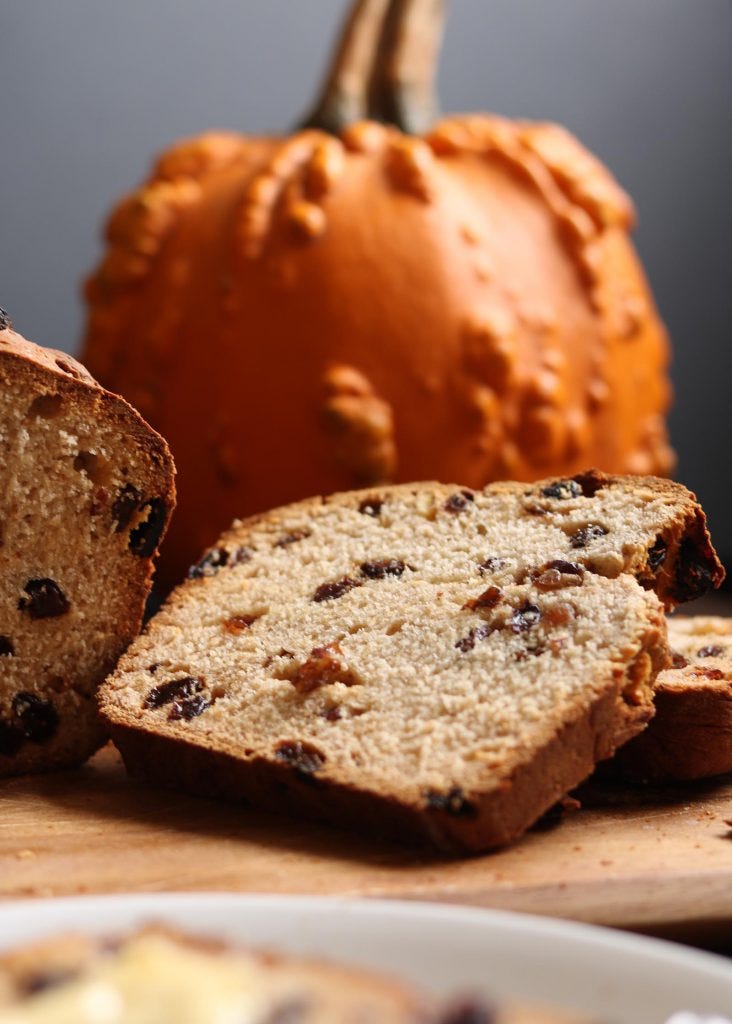Barmbrack Soul Cake Recipe
Barmbrack, also called bairin (loaf) breac (speckled) is an Irish fruit bread traditionally baked for Halloween, similar to the Welsh bara brith. In many recipes, the dried fruit was soaked overnight in cold tea or whiskey. It was often baked with trinkets or charms to foretell the future for the next year: a pea meant no marriage; a stick meant relationship disputes; a piece of cloth meant bad luck; a bean meant poverty; a coin meant riches and good fortune; and a ring meant marriage.

This Barmbrack Soul Cake recipe is a fun and tasty way to ensure good fortune for Samhain and the ‘new’ year. It’s adapted from a recipe for scones and traditional barmbrack, and contains ingredients that are imbued with positive sentiments for the new year:
pumpkin for abundance (fruit of the harvest and a fruitful womb full of seeds representing potential);
dried apples for health;
red currants or cranberries for love;
crystalised ginger for passion;
hazelnuts for wisdom;
pecans for wealth;
spices for fulfilment;
and sugar for joy.
Ingredients:
2 cups self-raising flour (gluten-free option)
1 tbsp caster sugar
60g salted butter, chilled and chopped
½ cup of Greek yoghurt
½ tsp ground nutmeg
1 tsp cinnamon
2/3 cup mashed cooked butternut pumpkin
½ cup dried apples, chopped
½ cup dried red currants or cranberries, chopped
½ cup crystallised ginger, chopped
½ cup hazelnuts, chopped
½ cup pecans, chopped
Extra water and yoghurt (for brushing)
Directions:
Preheat oven to 220°C/200°C fan forced. Line a baking tray with baking paper. Position the oven rack in the top half of the oven.
Chop dried apples, dried red currants or cranberries, crystallised ginger, hazelnuts and pecans into small pieces and place in a mixing bowl.
Mix mashed pumpkin and yoghurt with the apples, ginger and berries.
Sift flour, nutmeg, cinnamon, and sugar into a bowl. Add butter. Using fingertips, rub the butter into the flour mixture until the mixture resembles fine breadcrumbs.
Make a well in the centre of the mixture. Add pumpkin mixture. Using a flat-bladed knife, stir until a sticky dough forms. Turn out onto a lightly floured surface. Knead gently until just smooth.
Using a lightly floured rolling pin, gently roll the dough out until 2cm thick. Use a cutter or drinking glass to cut out scones. Press the leftover dough together. Repeat to make 12 scones. Cut a cross into the top of the scone.
Place scones, just touching, on the prepared tray. Brush with yoghurt and water mixture. Bake for 12 to 15 minutes or until golden and hollow when tapped on top. Serve with butter.





